Brief Overview
- St. Pio of Pietrelcina, widely known as Padre Pio, was an Italian priest and Capuchin friar who lived from 1887 to 1968.
- He is celebrated in the Catholic Church for bearing the stigmata, the wounds of Christ, for 50 years.
- Rare photographs of Padre Pio offer a glimpse into his life of humility, suffering, and miraculous gifts.
- These images capture moments of his ministry, including his time celebrating Mass and interacting with the faithful.
- His life was marked by extraordinary spiritual phenomena, such as bilocation and soul-reading, which are reflected in some of these photos.
- This article explores these rare images and their significance in understanding his legacy as a modern saint.
Detailed Response

Who Was Padre Pio?
St. Pio of Pietrelcina, born Francesco Forgione on May 25, 1887, in Pietrelcina, Italy, entered the Capuchin order at age 15. His early life was marked by poor health and a deep devotion to prayer, which shaped his path to priesthood. Ordained in 1910, he spent most of his life at the friary in San Giovanni Rotondo, where he became known for his sanctity. On September 20, 1918, while praying before a crucifix, he received the stigmata, making him the first priest in Church history to bear these wounds. These visible signs of Christ’s Passion remained with him until his death in 1968. Padre Pio’s life was one of intense suffering, both physical and spiritual, yet he offered it all for the salvation of souls. His humility and obedience to the Church, even under scrutiny, set him apart as a model of holiness. Rare photos from this period show a frail yet determined man, often with bandaged hands, serving the faithful. These images provide a tangible connection to his extraordinary witness. His canonization by Pope John Paul II in 2002 affirmed his enduring impact on the Church.
The Significance of Rare Photographs
Photographs of Padre Pio are more than historical records; they are windows into a life of grace. Many of these rare images were taken during his lifetime by those close to him, such as fellow friars or pilgrims. Unlike widely circulated pictures, these lesser-known shots capture candid moments of prayer, suffering, and service. For Catholics, they serve as reminders of God’s presence through his saints. The rarity of these photos stems from the limited technology of the early 20th century and Padre Pio’s own reluctance for public attention. One such image might show him with a serene expression, hands covered to hide the stigmata, reflecting his desire for humility. Another could depict him at the altar, where he spent hours celebrating Mass. These photos preserve the memory of a man who lived in union with Christ. They also counter skepticism about his miracles by grounding his story in real, visual evidence. For believers, they inspire faith in God’s power to work through ordinary people.
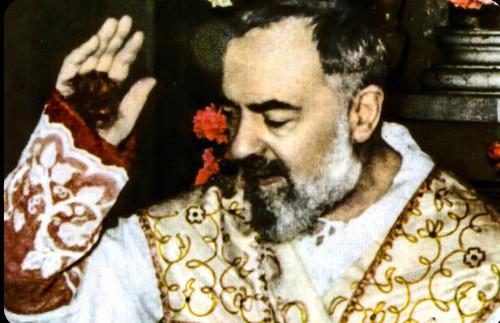
A Glimpse of the Stigmata
The stigmata are central to Padre Pio’s identity, and rare photos of his wounded hands are particularly striking. These wounds, which bled daily, were a source of both pain and wonder, drawing countless pilgrims to San Giovanni Rotondo. In one rare image, Padre Pio’s hands are partially uncovered, revealing the raw, open sores that defied medical explanation. Independent doctors examined them over decades, unable to attribute them to natural causes (CCC 547-550). The blood from these wounds reportedly carried a floral scent, known as the “odor of sanctity,” a phenomenon noted in other saints. This photo captures not just physical suffering but a spiritual mystery tied to Christ’s crucifixion (Galatians 6:17). Padre Pio himself was embarrassed by the attention they brought, often wearing mittens to conceal them. Yet, these images testify to his participation in the Paschal Mystery. They challenge modern viewers to consider the reality of supernatural signs. For the faithful, they affirm that God still marks his servants with visible graces.
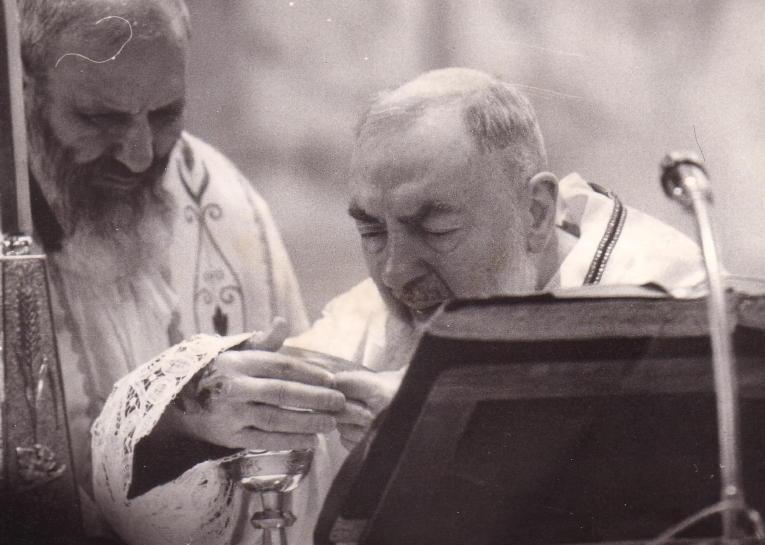
Celebrating Mass in Rare Moments
Padre Pio’s devotion to the Eucharist is well-documented, and rare photos of him at Mass reveal this love. He often spent hours celebrating the liturgy, entering deep prayer that sometimes led to mystical experiences. One such image might show him elevating the host, his face reflecting intense concentration. Witnesses reported that he seemed to relive Christ’s sacrifice, a claim supported by his own writings to spiritual directors. These photos are rare because photography was restricted during sacred rites, especially in his later years. His Masses drew thousands, many waiting weeks to attend, drawn by his reputation for holiness. The physical toll of the stigmata is evident in these images, with his frail frame bent under the weight of his vestments. Yet, his perseverance shines through, offering a lesson in sacrificial love. These moments highlight why he was called a “living crucifix.” They remain a powerful testament to the centrality of the Eucharist in Catholic life (CCC 1324-1327).
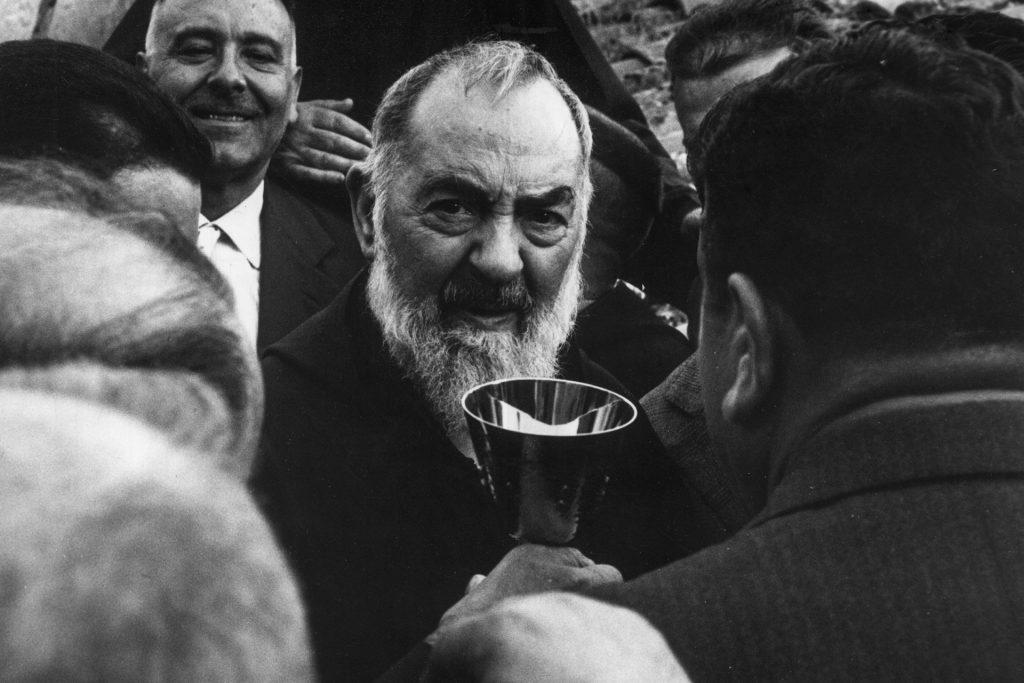
Interactions with the Faithful
Padre Pio’s ministry extended beyond the altar, as seen in rare photos of him with pilgrims. He spent up to 15 hours a day hearing confessions, using his gift of soul-reading to guide penitents. One image might show him blessing a child, his bandaged hand gently raised. Another could capture him listening intently to a penitent, his eyes conveying compassion. These photos reveal a priest who, despite personal suffering, prioritized others’ spiritual needs. His ability to know unconfessed sins astonished many, strengthening their faith in God’s mercy (CCC 1441-1442). These interactions were often spontaneous, making such candid shots scarce. Pilgrims flocked to him, seeing in him a conduit of divine grace. The images reflect a man fully given to his flock, embodying the call to serve (John 13:14-15). They invite Catholics today to seek reconciliation and trust in God’s forgiveness.
The Gift of Bilocation Captured
Bilocation, the ability to be in two places at once, is among Padre Pio’s most remarkable gifts, and rare photos hint at this mystery. Witnesses, including clergy, reported seeing him in distant locations while he remained in San Giovanni Rotondo. One such image might show him in an unexpected setting, like a hospital room, where he appeared to comfort the dying. These accounts align with Catholic tradition, where saints perform acts of mercy beyond human limits (CCC 828). The photos are rare because bilocation defies photographic proof, relying on testimony. Yet, their existence fuels discussion about God’s power over time and space. Padre Pio never sought attention for this gift, using it solely for others’ benefit. These images challenge skeptics while inspiring awe in believers. They suggest a life so united to Christ that physical boundaries dissolved (Colossians 1:27). For Catholics, they affirm the extraordinary ways God works through his saints.
Levitation and Mystical Phenomena
Reports of Padre Pio levitating during prayer add another layer to his mystique, and rare photos attempt to capture this. Fellow friars claimed to see him rise off the ground in ecstasy, a phenomenon tied to deep union with God. One blurry image might show him slightly elevated, though such moments were fleeting and private. These events recall saints like Joseph of Cupertino, showing continuity in Catholic mysticism (CCC 270-271). Photography of the time struggled to document such occurrences, making these images scarce and debated. Skeptics dismiss them, but believers see them as signs of divine favor. Padre Pio’s humility kept him from boasting about these experiences, focusing instead on his mission. The photos, though imperfect, point to a reality beyond the material world. They invite reflection on the power of prayer and God’s presence (Ephesians 3:20). For the Church, they underscore the holiness possible in ordinary lives.
The Odor of Sanctity
The floral scent from Padre Pio’s stigmata, known as the odor of sanctity, is a subtle but profound sign in rare photos. Pilgrims reported smelling it during Mass or confessions, linking it to his wounds. One image might show him with a crowd, some visibly reacting to this fragrance. This phenomenon, noted in other saints, signifies God’s grace at work (CCC 688). The rarity of these photos lies in their inability to capture scent, yet they preserve the context of this miracle. Padre Pio himself downplayed it, focusing on spiritual rather than sensory signs. The scent often accompanied healings, reinforcing his role as a conduit of mercy. These images connect viewers to a multisensory experience of holiness. They remind Catholics of the tangible ways God communicates through his saints (2 Corinthians 2:15). This gift remains a quiet testament to Padre Pio’s sanctity.
Padre Pio’s Final Mass
A rare photo of Padre Pio’s last Mass on September 22, 1968, holds special significance. Celebrated to mark 50 years of the stigmata, it was televised and attended by thousands. The image shows an elderly, weakened priest, yet his focus on the Eucharist is unshaken. His wounds, still present, vanished hours after his death the next day, a detail noted by witnesses. This photo captures the culmination of his sacrificial life, offered fully to God (CCC 1367). Its rarity comes from its timing, just before his passing at age 81. The frail figure contrasts with the spiritual strength he radiated, inspiring awe. This moment underscores the mystery of his stigmata’s healing at death. It serves as a visual homily on perseverance and faith (Hebrews 12:1-2). For Catholics, it’s a poignant reminder of a saint’s final earthly act of worship.
The Suffering Behind the Photos
Padre Pio’s suffering is a recurring theme in these rare images, revealing the cost of his gifts. Photos often show him pale and thin, a result of chronic illness and the stigmata’s toll. One might depict him resting, his face etched with pain yet peaceful. He offered this suffering for souls, a practice rooted in Catholic teaching on redemptive suffering (CCC 1505). His letters describe the agony of the wounds, especially from Thursday to Saturday, mirroring Christ’s Passion. These images counter romanticized views of sainthood, showing its human reality. Despite this, he continued his ministry, a testament to his endurance. The photos invite viewers to see suffering as a path to holiness (Romans 8:17). They challenge modern avoidance of pain, offering a model of acceptance. For the faithful, they reveal the depth of Padre Pio’s love for God and others.
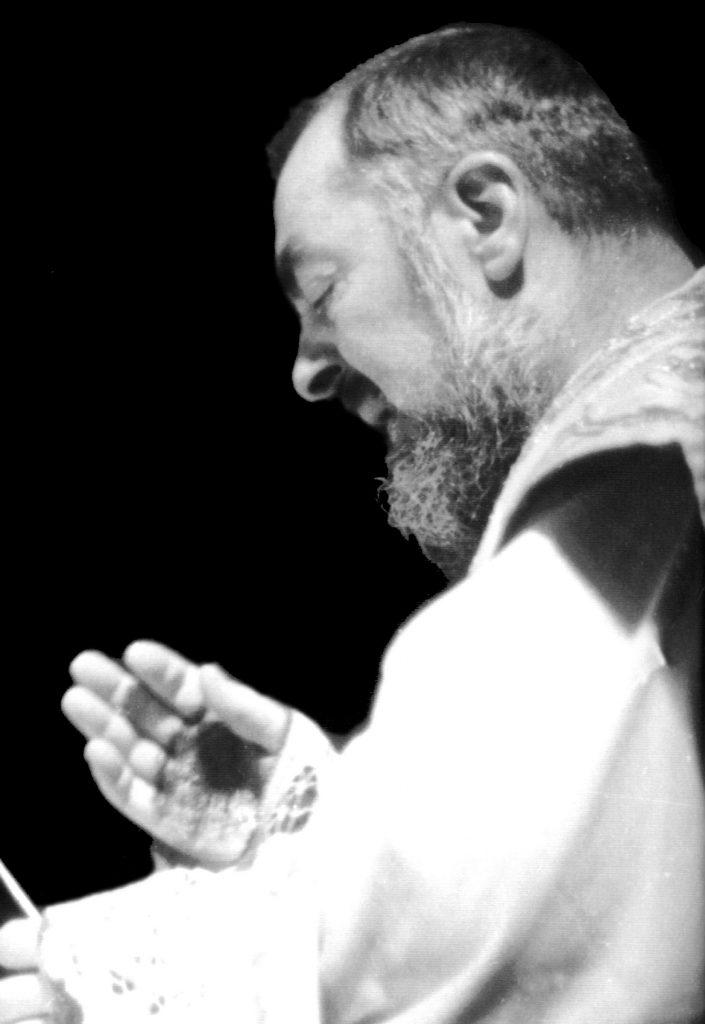
Pilgrims’ Perspectives in Photos
Rare photos of Padre Pio with pilgrims highlight his impact on ordinary people. Crowds gathered daily at San Giovanni Rotondo, seeking his blessing or confession. One image might show a sea of faces, all turned toward him in hope. These pilgrims came from diverse backgrounds, united by faith in his intercession. The photos capture a mutual exchange—Padre Pio giving grace, the faithful offering devotion. His gift of healing, documented in many cases, drew them, as seen in their eager expressions. These images are rare because they focus on the crowd, not just the saint. They reflect the Church as a community of believers (CCC 751-752). The pilgrims’ trust in him echoes the Gospel call to seek God’s servants (Matthew 7:7). These shots preserve a legacy of faith in action.
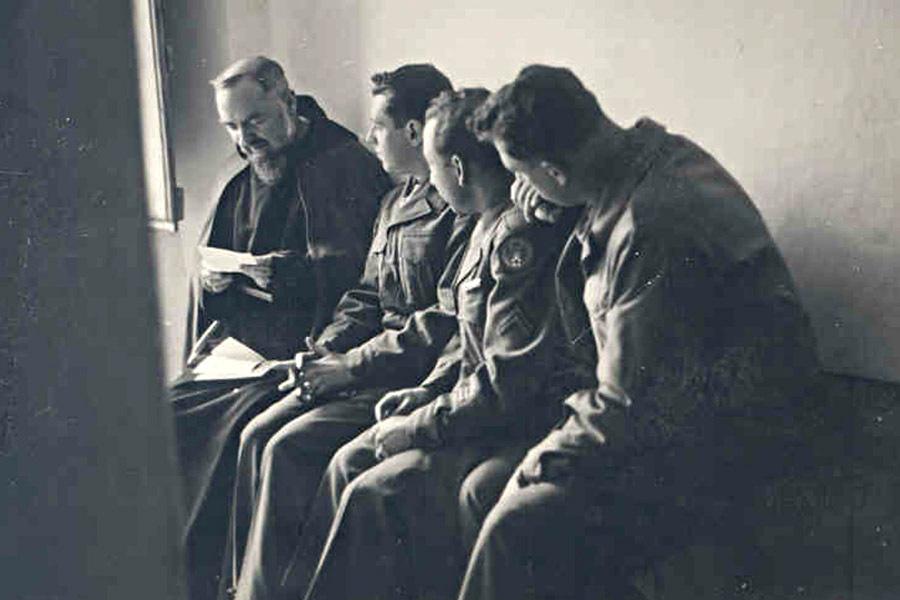
The Friary Life in Images
Life at the Capuchin friary is another facet revealed in rare photos of Padre Pio. He lived simply, following the order’s rule of poverty and prayer. One image might show him in his cell, surrounded by minimal belongings, deep in contemplation. Another could depict him with fellow friars, sharing a moment of fraternity. These photos are scarce due to the private nature of monastic life. They highlight his commitment to the Capuchin charism, rooted in St. Francis of Assisi’s example (CCC 914). His stigmata linked him to Francis, the first known stigmatist, a connection these images subtly evoke. The simplicity contrasts with his extraordinary gifts, grounding his story in humility. They offer a glimpse into the daily rhythm that sustained his holiness (Psalm 119:164). For Catholics, they model a life of discipline and devotion.
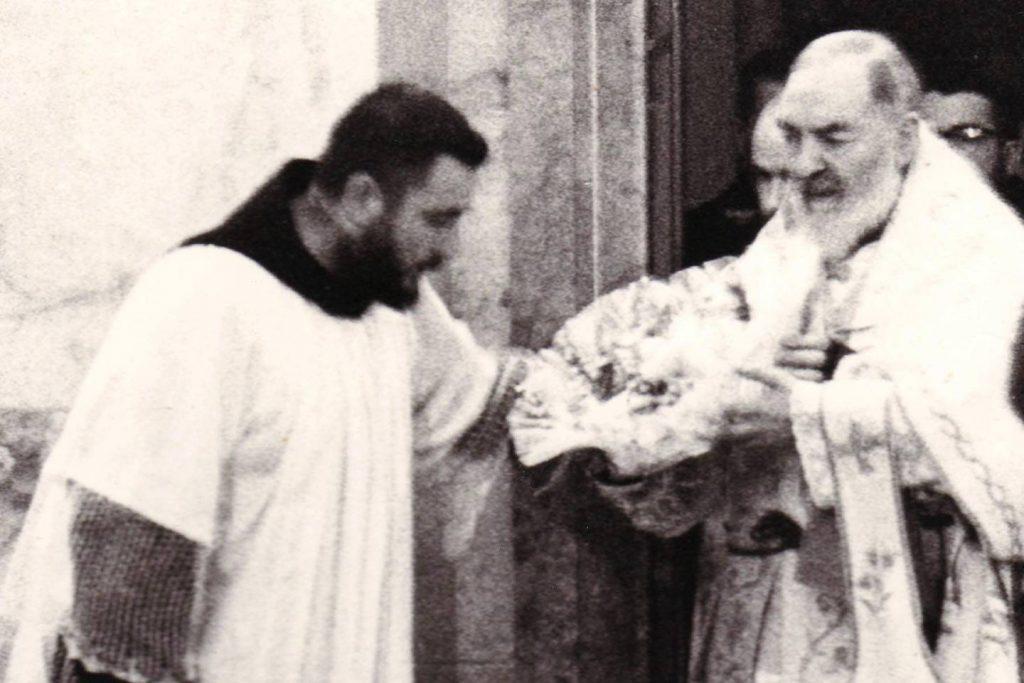
Padre Pio’s Legacy in Pictures
The legacy of Padre Pio endures, and rare photos play a role in keeping it alive. After his death, his body was exhumed in 2008 and found partially preserved, a sign of sanctity for many. One photo might show his remains displayed, drawing pilgrims anew. His hospital, Casa Sollievo della Sofferenza, continues his mission of mercy, a fact tied to images of its founding. These photos are rare because they span decades, from his life to posthumous veneration. They connect past and present, showing his ongoing influence (CCC 2030). His canonization drew over 500,000 to Rome, a testament captured in later images. These visuals affirm his role as a modern saint for all ages. They inspire Catholics to seek his intercession today (James 5:16). His life, preserved in these shots, remains a call to holiness.
Skepticism and Verification
Some rare photos of Padre Pio faced skepticism, especially those tied to his miracles. Critics questioned the stigmata, suggesting self-infliction with acid, a claim debunked by medical exams. One image might show him under scrutiny, surrounded by investigators. The Church conducted thorough inquiries, affirming his phenomena as authentic (CCC 67). These photos are rare because they document a contentious period, when he was briefly banned from public ministry. His obedience during this time, seen in his resigned posture, silenced doubters. The images counter false narratives with visual truth. They remind Catholics that saints often face trials, yet God vindicates them (1 Peter 4:14). The verification process underscores the Church’s care in discerning holiness. For believers, these photos strengthen trust in Padre Pio’s sanctity.
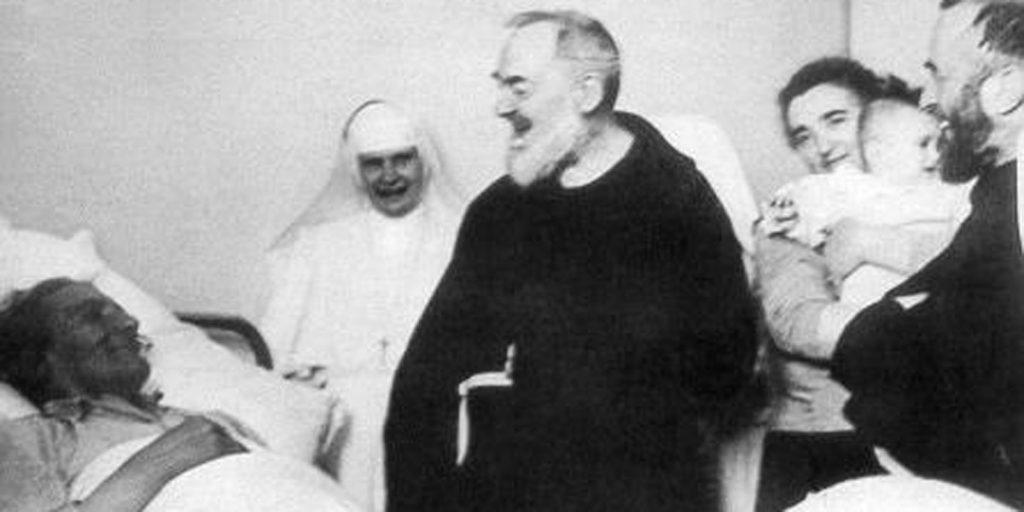
Healing Miracles in Focus
Healing miracles attributed to Padre Pio are hinted at in rare photos with the sick. One might show him touching a child, later reported healed of blindness. Another could depict a crowd holding crutches, discarded after his prayers. These events, certified by the Church, highlight his intercessory power (CCC 1508). The photos are rare because healings were personal, not staged for cameras. Witnesses, like Gemma di Giorgio, a girl born without pupils who gained sight, attest to his gifts. These images capture hope amid suffering, a core Catholic theme. They challenge a materialist worldview, pointing to divine intervention (Mark 5:34). The scarcity of such shots enhances their impact, making each a treasure. For the faithful, they affirm Padre Pio’s role as a healer in Christ’s name.
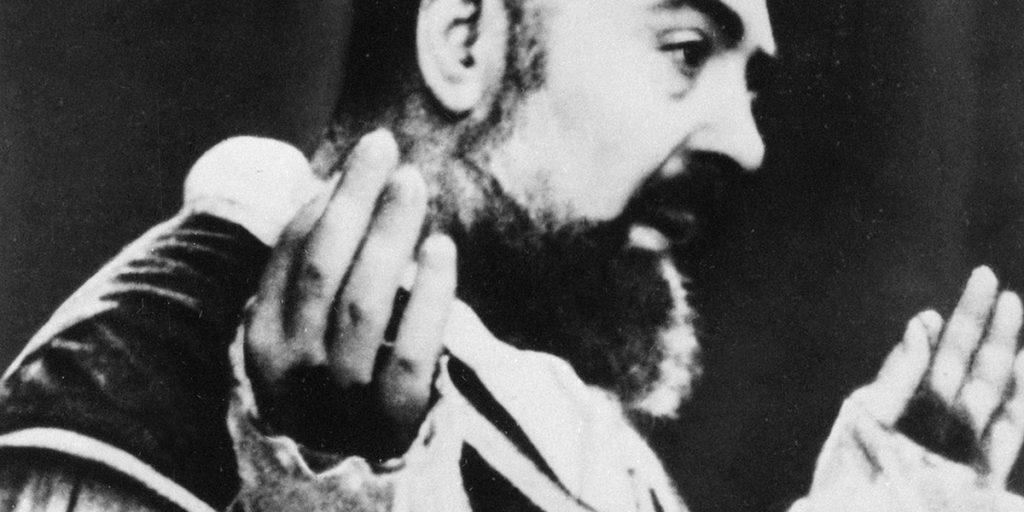
A Call to Prayer
Padre Pio’s love for prayer shines in rare photos of him with a rosary or in contemplation. He prayed multiple rosaries daily, urging others to do the same. One image might show him clutching beads, his face serene despite pain. This devotion reflects Catholic teaching on prayer as a lifeline to God (CCC 2559-2565). The photos are rare because they capture private moments, not public displays. His famous advice, “Pray, hope, and don’t worry,” resonates in these stills. They show a man sustained by faith, even under trial. These images call Catholics to deepen their own prayer lives (1 Thessalonians 5:17). They link his miracles to a foundation of trust in God. For believers, they are an invitation to imitate his spiritual discipline.
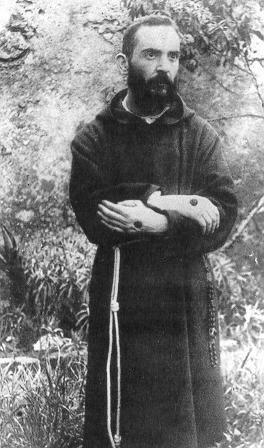
The Humility of a Saint
Humility defines Padre Pio in these rare photos, despite his extraordinary gifts. He shunned fame, as seen in images where he avoids the camera’s gaze. One might show him turning away from a crowd, hands hidden. This aligns with Catholic virtue, where holiness seeks God, not glory (CCC 2540). The rarity of these shots reflects his desire for obscurity, a trait rare in a public figure. His obedience to Church restrictions, even when unjust, shines through in his demeanor. These photos reveal a man who saw himself as God’s instrument, not a marvel. They contrast with modern self-promotion, offering a countercultural lesson (Philippians 2:3). For Catholics, they model true sanctity. His humility, frozen in time, remains his greatest witness.
Padre Pio’s Death and Beyond
Photos of Padre Pio’s final days and funeral are among the rarest, capturing his passage to eternity. One might show him frail in bed, hours before his death on September 23, 1968. Another could depict the massive crowd—over 100,000—at his funeral, a testament to his impact. His wounds healing at death, as noted by a doctor, add mystery to these images. The rarity stems from the personal nature of these moments, rarely photographed. They mark the end of a life offered fully to God, fulfilling his priestly call (CCC 1554). These shots bridge his earthly and heavenly roles, as he continues to intercede. They evoke awe at God’s plan for his saints (Revelation 14:13). For the Church, they affirm his eternal presence. These images seal his legacy as a saint for all time.
Why These Photos Matter Today
Rare photos of Padre Pio matter because they bring a distant saint closer to modern Catholics. They show a real person—suffering, praying, serving—behind the miracles. One might depict him laughing with friars, humanizing his story. Another could show him blessing a soldier, tying him to 20th-century struggles. Their scarcity makes them precious, preserving moments nearly lost to time. They challenge a secular age to consider the supernatural, rooted in Catholic faith (CCC 37). These images inspire intercession, as millions still pray to him. They connect believers to a living tradition of sainthood (Hebrews 12:1). For today’s Church, they offer hope amid doubt. Ultimately, they reveal a priest whose life still speaks of God’s love and power.
Conclusion: A Visual Testimony
These rare photos of Padre Pio are more than artifacts; they are a visual testimony to a life of grace. Each image—whether of his stigmata, Mass, or pilgrims—reflects a facet of his holiness. They capture a man who bore Christ’s wounds, served his flock, and trusted God utterly. Their rarity enhances their value, offering fresh perspectives on a familiar saint. For Catholics, they affirm the reality of miracles and the call to sanctity (CCC 2013-2014). They bridge past and present, showing God’s work in a modern age. These shots invite reflection on suffering, prayer, and service as paths to heaven. Padre Pio’s life, seen through these lenses, remains a gift to the Church. They encourage believers to seek his prayers and follow his example. In them, we see a humble priest chosen for extraordinary purposes, a truth as clear today as it was then.
Signup for our Exclusive Newsletter
- Add CatholicShare as a Preferred Source on Google
- Join us on Patreon for premium content
- Checkout these Catholic audiobooks
- Get FREE Rosary Book
- Follow us on Flipboard
-

Discover hidden wisdom in Catholic books; invaluable guides enriching faith and satisfying curiosity. Explore now! #CommissionsEarned
- The Early Church Was the Catholic Church
- The Case for Catholicism - Answers to Classic and Contemporary Protestant Objections
- Meeting the Protestant Challenge: How to Answer 50 Biblical Objections to Catholic Beliefs
As an Amazon Associate, I earn from qualifying purchases. Thank you.
